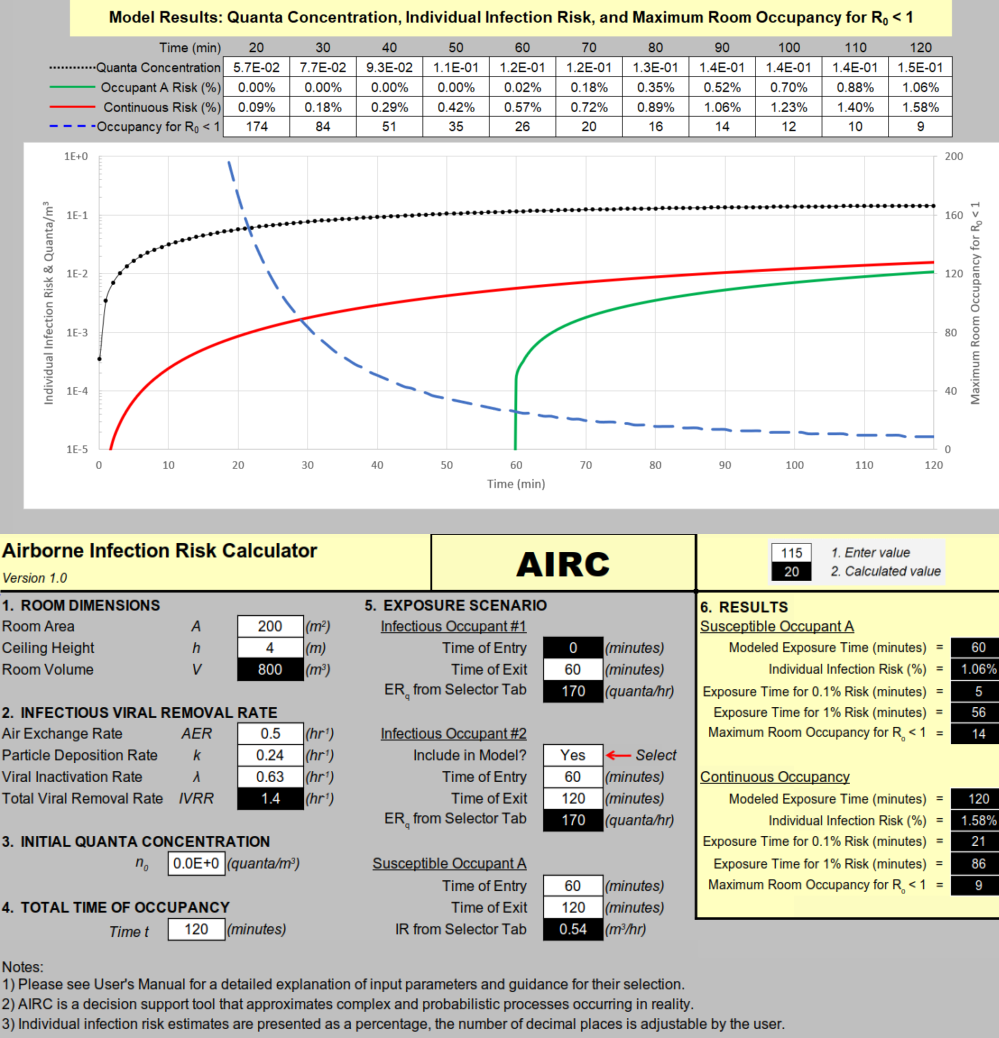The Airborne Infection Risk Calculator (AIRC) was developed by researchers at CUNY BPL, the University of Cassino and Southern Lazio Department of Civil and Mechanical Engineering (Cassino, Italy) and the International Laboratory for Air Quality and Health (ILAQH, Queensland University of Technology, Brisbane, Australia). AIRC is an airborne contagion modeling tool programmed in Microsoft Excel and designed to assist facility managers, building engineers, and public and occupational health professionals in prospectively evaluating individual infection and community transmission risks associated with specific indoor environments.
AIRC can help users address two primary questions related to the risks associated with occupying an indoor space when community transmission of an infectious airborne pathogen, such as SARS-CoV-2, is occurring:
- What is the potential infection risk associated with varying lengths of stay in the space?
- What number of occupants helps maintain a basic reproduction number (R0) less than one to prevent the exposure from further contributing to disease spread in the population.
The target users of AIRC are building managers, engineering consultants, and public, occupational, and environmental health scientists. Users should be proficient in Microsoft Excel and have a basic understanding of building systems and indoor air quality.
AIRC is based on the novel risk modeling approach developed for SARS-CoV-2 presented in the following papers:
Buonanno, G., Stabile, L., Morawska, L. Estimation of Airborne Viral Emission: Quanta Emission Rate of SARS-CoV-2 for Infection Risk Assessment. Environment International. https://doi.org/10.1101/2020.04.12.20062828.
Buonanno, G., Morawska, L., Stabile, L. Quantitative Assessment of the Risk of Airborne Transmission of SARS-CoV-2 Infection: Prospective and Retrospective Applications. Environment International. https://doi.org/10.1101/2020.06.01.20118984
A. Mikszewski, L. Stabile, G. Buonanno, L. Morawska. The Airborne Contagiousness Of Respiratory Viruses: A Comparative Analysis And Implications For Mitigation. medRxiv 2021.01.26.21250580. https://doi.org/10.1101/2021.01.26.21250580
What’s New in AIRC (beta 3.0)
- Updated SARS-CoV-2 emission rates and included an adjustable multiplier for variants;
- Included predictive emission rate distributions for four additional pathogens (tuberculosis, rhinovirus, measles, and seasonal influenza);
- Added lognormal emission rate distributions for multiple infected occupants (up to 10); and
- Included secondary transmission histograms for specified room occupancies.
AIRC v2.1
- Minor improvements to charts
AIRC v2.0
- Added stationary exposure conditions (SEC) model with complete solution of the infection risk equations (AIRC SEC).
- Changed default values by activity level to 66th and 90th percentile instead of 85th percentile for the Version 1.0 modeling sheet, now termed the AIRC transitional exposure conditions (TEC) model. The 66th percentile values are used for probability of infection estimates and the 90th percentile values are used for room occupancy calculations.
- Changed Version 1.0 terminology of “individual infection risk” estimates to “probability of infection” estimates for the AIRC TEC model (see new Glossary).
- Added ability to model any number of infectious occupants present at time zero.
- Added ability to specify two separate custom emission rates and inhalation rates for different occupants for the AIRC TEC model.
